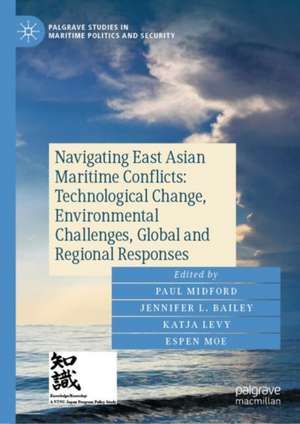Navigating East Asian Maritime Conflicts: Technological Change, Environmental Challenges, Global and Regional Responses: Palgrave Studies in Maritime Politics and Security
Editat de Paul Midford, Jennifer Bailey, Katja Levy, Espen Moeen Limba Engleză Hardback – 10 sep 2024
Preț: 736.16 lei
Preț vechi: 897.75 lei
-18% Nou
Puncte Express: 1104
Preț estimativ în valută:
140.88€ • 146.54$ • 116.31£
140.88€ • 146.54$ • 116.31£
Carte tipărită la comandă
Livrare economică 15-29 aprilie
Preluare comenzi: 021 569.72.76
Specificații
ISBN-13: 9783031519888
ISBN-10: 3031519884
Ilustrații: X, 240 p. 25 illus.
Dimensiuni: 148 x 210 mm
Greutate: 0.69 kg
Ediția:2024
Editura: Springer Nature Switzerland
Colecția Palgrave Macmillan
Seria Palgrave Studies in Maritime Politics and Security
Locul publicării:Cham, Switzerland
ISBN-10: 3031519884
Ilustrații: X, 240 p. 25 illus.
Dimensiuni: 148 x 210 mm
Greutate: 0.69 kg
Ediția:2024
Editura: Springer Nature Switzerland
Colecția Palgrave Macmillan
Seria Palgrave Studies in Maritime Politics and Security
Locul publicării:Cham, Switzerland
Cuprins
Part I: Framework.- Chapter 1: Introduction.- Chapter 2: The Law of the Sea and its Relevance for Maritime Conflicts in East Asia.- Part II: Security Dimensions.- Chapter 3: Unmanned maritime platforms and the undersea struggle in the South China.- Chapter 4: Low Intensity Maritime Conflicts, Escalation Management and Technology.- Chapter 5: Military Automation, Robotics, and Maritime Security, Understanding New Dynamics in Conflict Escalation.- Part III: East Asian Maritime Competition and the Arctic.- Chapter 6: The Impact of Russia’s Ukraine Invasion on the Arctic-From Cooperation to Conflict?.- Chapter 7: China’s Arctic Strategy, From Follow-up to “Creative Involvement”.- Chapter 8: Japan’s Arctic Strategy, Countering East Asian Maritime Insecurity and Competition with China.- Part IV: Seabed Mining.- Chapter 9: Rare and Infinite The Minami-torishima “Semi-infinite” Rare Earth Elements and the historical dynamics of Deep-Sea Mining.- Chapter 10: Japan’s Seabed Mining as a Cause and Result of East Asian Maritime Tensions.- Chapter 11: Limited semi-infinity Japan's deepsea resources against the backdrop of China's rare earth.- Part V: Fishing and Renewable Energy.- Chapter 12: China's Digitalised Fishery Reform and Its Implications on the East Asian Maritime Order.- Chapter 13: Japan's New Whaling Policy, Marine Management in an Evolving Security and Technological Setting.- Chapter 14: Offshore Wind in Japan, Energy Production and Conflict Reduction?.- Part VI: Conclusions.- Chapter 15: Conclusions.
Notă biografică
Paul Midford is Professor of Political Science, Meiji Gakuin University, Japan.
Jennifer Bailey is Professor of Political Science, Norwegian University of Science and Technology (NTNU), Norway.
Katja Levy is Associate Professor of Political Science, Norwegian University of Science and Technology (NTNU), Norway.
Espen Moe is Professor of Political Science, Norwegian University of Science and Technology (NTNU), Norway.
Jennifer Bailey is Professor of Political Science, Norwegian University of Science and Technology (NTNU), Norway.
Katja Levy is Associate Professor of Political Science, Norwegian University of Science and Technology (NTNU), Norway.
Espen Moe is Professor of Political Science, Norwegian University of Science and Technology (NTNU), Norway.
Textul de pe ultima copertă
“This volume brings together leading experts to examine the potentials for maritime conflict and cooperation in a region where geopolitical rivalries are intensifying. I highly recommend it to scholars, practitioners, and students alike.”
—Miranda A. Schreurs, Professor, Technical University of Munich.
“With an original approach to maritime conflicts that focuses on the effects of technological and environmental change, this is a must-read for anyone interested in East Asian peace and security!”
— Stein Tønnesson, Research Professor Emeritus, Peace Research
Institute Oslo
“A crucial read for anyone interested in understanding the complexities of maritime conflicts in East Asia and their broader global implications.”
—Yurika Ishii, Associate Professor, National Defense Academy of Japan
“The volume offers multi-disciplinary perspectives that reach across disciplinary boundaries and connect perspectivesfrom natural sciences and engineering to social sciences and policy.”
—Clive Schofield, Professor, University of Wollongong, Australia As technological development and diffusion have greatly increased the resources states can recover from maritime space, the stakes of these conflicts have grown. Nowhere is this clearer than in East Asia. This book examines how technological change and diffusion impact East Asian maritime conflicts, and approaches for conflict management and resolution.
Paul Midford is Professor of Political Science, Meiji Gakuin University, Japan.
Jennifer Bailey is Professor of Political Science, Norwegian University of Science and Technology (NTNU), Norway.
Katja Levy is Associate Professor of Political Science, Norwegian University of Science and Technology (NTNU), Norway.
Espen Moe is Professor of Political Science, Norwegian University of Science and Technology (NTNU), Norway.
—Miranda A. Schreurs, Professor, Technical University of Munich.
“With an original approach to maritime conflicts that focuses on the effects of technological and environmental change, this is a must-read for anyone interested in East Asian peace and security!”
— Stein Tønnesson, Research Professor Emeritus, Peace Research
Institute Oslo
“A crucial read for anyone interested in understanding the complexities of maritime conflicts in East Asia and their broader global implications.”
—Yurika Ishii, Associate Professor, National Defense Academy of Japan
“The volume offers multi-disciplinary perspectives that reach across disciplinary boundaries and connect perspectivesfrom natural sciences and engineering to social sciences and policy.”
—Clive Schofield, Professor, University of Wollongong, Australia As technological development and diffusion have greatly increased the resources states can recover from maritime space, the stakes of these conflicts have grown. Nowhere is this clearer than in East Asia. This book examines how technological change and diffusion impact East Asian maritime conflicts, and approaches for conflict management and resolution.
Paul Midford is Professor of Political Science, Meiji Gakuin University, Japan.
Jennifer Bailey is Professor of Political Science, Norwegian University of Science and Technology (NTNU), Norway.
Katja Levy is Associate Professor of Political Science, Norwegian University of Science and Technology (NTNU), Norway.
Espen Moe is Professor of Political Science, Norwegian University of Science and Technology (NTNU), Norway.
Caracteristici
Focuses on maritime tensions in East Asia Addresses the question of how patterns of conflict and cooperation in East Asia Considers East Asia as a subsystem of international politics








